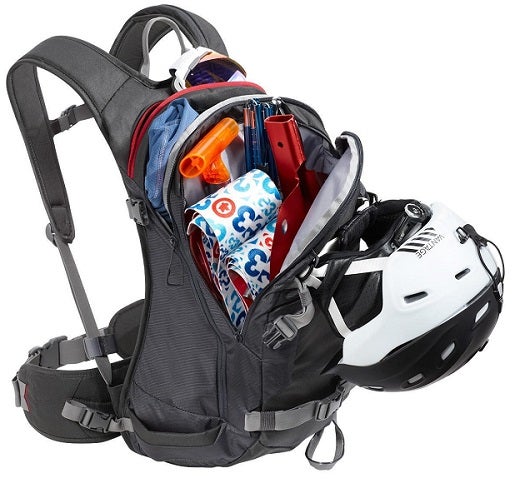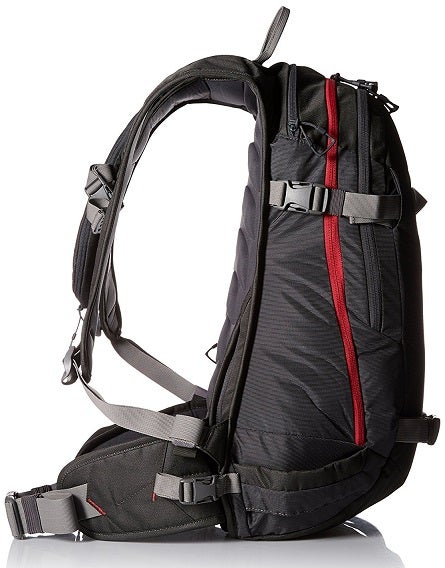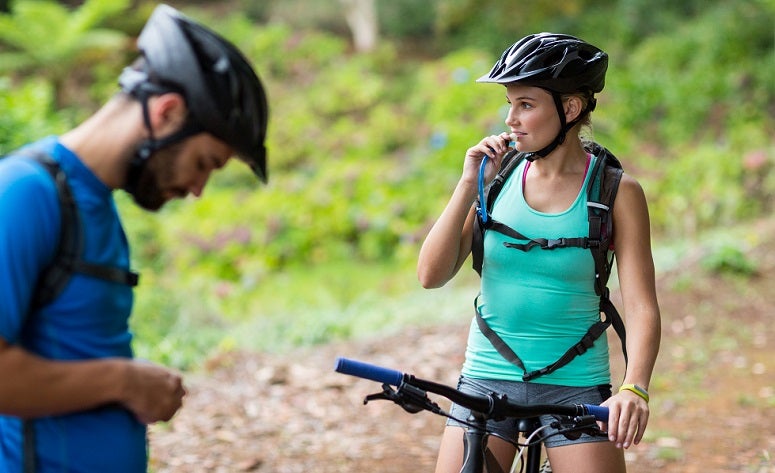
Our Editors independently research, test, and rate what we feel are the best products. We use affiliate links and may receive a small commission on purchases.
Hydration packs stand apart from the crowd by including dedicated space for a water bladder which might be for general use or more specific like running.
Most dedicated hydration packs are small day packs or athletic packs for biking, skiing, snowboarding or running where water is a priority.
While it is possible to find the best hydration packs in sizes ranging up to expedition backpacks in the 70L – 90L size range, we’ll focus primarily on smaller packs.
When considering a hydration backpack you’ll first want to identify what activities you’ll primarily use the bag for.
Best Hydration Packs
| CamelBak Powderhound Ski Hydration Pack | Osprey Packs Skarab Hiking Hydration Backpack | M.U.L.E. Mountain Biking Hydration Pack | |
|---|---|---|---|
| Best For: | Skiing/Snowboarding | Hiking, Kayaking, Backpacking & Paddleboarding | Biking, Walking |
| Water Capacity: | 3 Liters | 2.5 Liters | 3 Liters |
| Storage: | 12 Liters | 30 Liters | 12 Liters |
| Features: | Insulated bladder and water line | Magnetic hose retention | Breathable air mesh back panel |
For more of my travel gear recommendations, have a look through these popular Outside Pursuits guide links: Hiking Backpacks, Travel Backpacks, Solar Chargers.
Quick Answer: The 7 Best Rated Hydration Packs For 2021
- CamelBak Powderhound 12 Ski Hydration Pack
- CamelBak Phantom Snowboard Hydration Pack
- Osprey Packs Skarab Hiking Hydration Backpack
- Osprey Skimmer Women’s Hiking Hydration Backpack
- Osprey Kitsuma 7 Women’s Hydration Backpack
- M.U.L.E. Mountain Biking Hydration Pack
- CamelBak Ultra Pro Running Hydration Vest
So now that we have that out of way, lets take a quick look at the top rated hydration packs, full reviews and our buying guide is below.
Hydration Pack Reviews
#1 CamelBak Powderhound 12 Ski Hydration Pack
The Caper is best suited for skiers and specifically for carrying skis but will accommodate a snowboard as well. The Caper has a 3 liter hydration bladder with the “Therminator” harness that keeps the hose and bladder from freezing up in subzero temperatures.
While being smaller than the Phantom (up next), it still has plenty of storage for your helmet, avalanche probe, snacks and/or lunch plus a nice fleece lined pocked for your goggles.
The Caper is not so large however that it’s not uncomfortable to wear on the ski lift. The smaller size also means it should fit in your ski or snowboard bag so you wont have to carry in your suitcase for traveling.
The Caper also has Camelbaks lifetime warranty and is probably the best hydration pack for skiing at a very reasonable price.
#2 CamelBak Phantom Snowboard Hydration Pack
If your looking for a hydration backpack for snowboarding the Phantom is without a doubt one of the better choices. The Phantom has 21 liters of total storage with a 3 liter hydration bladder.
The carry straps are designed to not only carry your snowboard (or skis) but a helmet, avalanche beacon, goggles, pretty much all the gear you will need for a day of boarding or skiing.
What makes it the ideal hydration pack for winter sports is the fact that it has the “Therminator” harness system that insulates the hose and bladder from freezing.
One really nice touch of the Camelbak Phantom, is the zippers that were made to be opened wearing gloves. Sounds like a small thing, but believe me you will appreciate this feature!
The lifetime warranty and features make this the best hydration pack for snowboarding you can buy.
Best Hydration Packs For Hiking
#3 Osprey Packs Skarab Hiking Hydration Backpack
This hydration backpack comes prepared with the top-zip Osprey 2.5L hydration bladder and 30L of storage space for day hikes. This is the largest capacity hydration pack we’ll review here.
Like many of the Osprey hydration packs, this pack is a great solution for general commuters or weekend hikers looking to bag a few trails.
With several hose routing options available, you’ll be able to dial the pack in to fit your needs without much trouble at all.
The hiking water backpack is designed to carry everything from helmets to sleeping pads with room to spare.
One of my favorite features is the padded hip belt with integrated pockets – one of the handiest features on any pack! I would say this is the best hydration pack for hiking or backpacking.
Best Hydration Pack For Women
#4 Osprey Skimmer Women’s Hiking Hydration Backpack
This is a great hybrid bag that is small enough to be taken on a hike, jog, or ride yet large enough to pass as an everyday carry type of bag.
28L of pack space and a 2.5L top-zip hydration bladder mean you won’t be needing to fill up very often and there’s just enough room for a change of running clothes at the office.
It has a dedicated micro fleece sunglasses pocket, carrying space for pads and helmets, and various attachment points make for a great all around bag.
If you bike riding there is plenty of space to organize your riding essentials, this hydration pack also features Osprey’s “AirScape” back panel so can stay dry and comfortable all day.
If you’re looking for the best women’s hydration bladder with an all-around attitude, this is probably your best pick.
Best Hydration Pack For Mountain Biking
#5 M.U.L.E. Mountain Biking Hydration Pack
This full featured hydration pack is made for biking and that actually matters due to the design and styling. This is an excellent MTB hydration pack, it gives you 3 Liters of water, plenty for an all day ride.
The hydration bladder can be secured using compression straps and the integrated holding power of mesh expansion panels.
Reflective piping on the back of the bag keeps bike riders visible in the evenings, too.
This camelbak hydration pack with 12L of storage is perfect for bike riding, half day hikes, kayaking and paddle boarding.
This is not an insulated hydration pack, so being I like cold water, I fill it a 1/3 to a 1/4 full, then freeze the water. This keeps the water cold for hours! You could also throw some ice cubes in it…
There several zippered pockets that are plenty big enough to hold your keys, wallet, phone, some energy bars and even a packable rain jacket, like the Marmot Precip.
The CamelBak Rogue is the best hydration pack for mountain biking.
#6 Osprey Kitsuma 7 Women’s Hydration Backpack
One cool feature on this water backpack is the magnetic hose retention system for easy release and storage of the hose system. Quick access hip belt pockets for keys, snacks, or energy gel are always a welcome addition and this pack delivers.
A small amount of internal storage and room to strap bulky gear to the outside make this a good hydration bladder for specific needs.
7L of storage and 2.5L top-zip hydration bag create the core of what this bag is all about. Mesh shoulder straps and a highly adjustable sternum strap are made to work with a wide range of female body sizes.
With a dedicated external helmet pocket, this bag might be the perfect minimal commuter bag for the female bicyclist.
Consider using the external pockets for bulky layers if you’re not the helmet type.
This may be the best hydration pack for women with it’s versatility.
Best Hydration Pack For Running
#7 CamelBak Ultra Pro Running Hydration Vest
This Camelback water pack is an excellent solution for runners looking to acquire a balanced, refined and streamlined running hydration pack made specifically for long distance runs.
The pack is designed specifically for long runs with a 1.5L water capacity and room for an extra layer, gloves, hat, keys and maybe some suntan lotion.
The harness system is highly adjustable, features tons of easy access front pockets for getting to your nutrition without stopping, and overall shows a low profile.
On the front, you’ll find space for two extra water bottles, energy gels, and a phone pocket.
Two front sternum straps help lock the pack down to minimize movement while running.
In my opinion this is the best running backpack.
Hydration Pack Comparison Table
| Hydration Pack | Bladder Size | Storage | Pack Weight | Best Use | Rating | |
|---|---|---|---|---|---|---|
| CamelBak Powder Hound Hydration Pack | 3 Liters | 12 Liters | 2.1 lbs | Skiing, Snowboarding | 4.8 / 5.0 | |
| CamelBak Phantom Ski Hydration Pack | 3 Liters | 21 Liters | 2.2 lbs | Skiing, Snowboarding | 4.8 / 5.0 | |
| Osprey Packs Skarab Hiking Hydration Backpack | 2.5 Liters | 30 Liters | 2.25 lbs | Hiking, Biking | 4.3 / 5.0 | |
| M.U.L.E. Mountain Biking Hydration Pack | 3 Liters | 12 Liters | 1.9 lbs | Biking, Walking, Kayaking, Paddleboarding | 4.4 / 5.0 | |
| Osprey Skimmer Women's Hiking Hydration Backpack | 2.5 Liters | 28 Liters | 1.75 lbs | Hiking, Biking | 4.1 / 5.0 | |
| Osprey Kitsuma 7 Women's Hydration Backpack | 2.5 Liters | 7 Liters | 1.75 lbs | Hiking, Biking | 4.6 / 5.0 | |
| CamelBak Ultra Pro Running Hydration Vest | 1.5 Liters | .5 Liters | .75 lbs | Running | 4.5 / 5.0 |
How to Choose the Best Hydration Pack – Buyers Guide
- Fitment and Stability
- Balance
- Compatibility
- Cleaning
- Insulation
- Refilling a Bladder
- Pack Compressibility
- Hip Belts
- FAQs For Hydration Packs
- Final Thoughts
 Depending how you will use your hydration pack will determine what features are important to you. Runners may want a vest-type model with space for extra water bottles on the front of the pack.
Depending how you will use your hydration pack will determine what features are important to you. Runners may want a vest-type model with space for extra water bottles on the front of the pack.
Hikers and those seeking an everyday type bag will want to find a larger volume pack for a wider range of options.
Fitment and Stability
Without a doubt one of the biggest drawbacks to hydration packs for athletic pursuits is their tendency to jostle about while running, jogging, or maneuvering. Most hydration bladders are slim, trim, and streamlined when compared to their larger hiking counterparts.
That being said, however, the weight of several liters of water moving on your back during the motions of running can become tiring, irritating, and abrasive.
Make sure when ordering a hydration pack that the pack is designed to fit your intended sport appropriately. Running hydration packs should fit snugly to minimize bounce.
Balance
Having a large amount of dense water on your back can create a huge imbalance for many athletes. Some hydration backpacks feature front hip belt pockets or sternum strap add-ons.
These packs may be an advantage for some as the extra frontal storage space creates opportunities to balance your load by carrying weight on the front of the pack as well as the back.
Compatibility
When choosing a hydration bladder, it’s not entirely necessary to purchase a total unit. What do I mean by that? Most hydration bladders can be used in any pack so long as they meet the size requirements of the bag.
So, a 5L hydration bladder will fit a 5L compatible hydration pack regardless of the brand and model.
It’s also really convenient that Platypus hydration tubes are cross compatible with Camelback hydration tubes so the two can easily be switched out.
Cleaning
If the hydration pack you’re choosing comes with its own bladder, you’ll need to think about cleaning. When choosing a hydration bladder, it’s easy to forget that you’ll have to eventually clean the thing. This can be a huge pain in the butt if your bladder is oddly shaped or has a small aperture.
Without a doubt, the easiest to clean are zip top bladders where the entire body of the bladder can be accessed by a large top opening. This is where Camelbak water backpacks excel, they all have a large screw top opening.
To make things simple, in this case it makes a lot of sense to buy a specialized cleaning kit from the manufacturer and be sure to follow the manufacturer recommended cleaning procedures.
If you happen to forget and store your pack with the hydration bladder still full of water, be sure to thoroughly cleaning it out before drinking from it again.
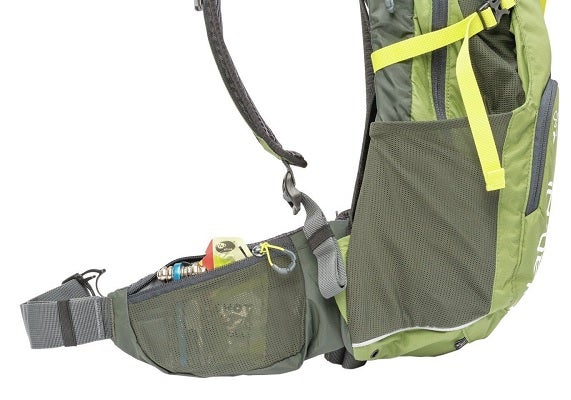
Insulation
If you’re planning to use your hydration pack in extreme weather such as deep winter for skiing or snowboarding, you may want to consider insulation. Under very cold circumstances the bladder or hose may freeze causing damage or inability to drink from the pack. Both packs and hydration hoses can be insulated for cold weather performance.
Don’t forget to protect the bite valve on your water bladder. Look for aftermarket neoprene valve covers to keep the water from freezing up inside the bite valve.
Alternatively, you can try to keep the pack, hose, and bite valve all underneath your outermost layer. Put on your insulation layer, then put on the pack, and put your hardshell jacket over all of it. This will keep everything from freezing up.
Pro Tip: During hot summer weather you won’t have to worry about freezing, but we all know packs get way too hot! To keep cool during the summer you can try this simple trick:
- Fill the water bladder halfway
- Place in the freezer with the hose facing up
- Freeze overnight
- Fill the rest of the way
Now you have a self cooling system that will keep you air conditioned for hours. Plus the water you drink will be nice and cold all day. Just make sure not to freeze the hose opening or you’ll have to wait for it to melt!
Refilling a Bladder
At home it’s easy to fill up your water bladder but in the field it’s a bit different. Hikers and backpackers are already familiar with their favorite method of water purification in the field. Additionally, we all know it can be a real pain sometimes trying to hold the water pump, hold the bottle, purify the water without knocking something over, etc…
When it comes to doing this same process, whether you’re pumping water or using chemical purification, a water bladder makes things even worse! Because they’re soft, bladders don’t hold themselves up so it’s a real trick dipping them in the stream and filling them without spilling it everywhere or holding them while you try to pump filtered water into them.
The solution is to use a lightweight cup to scoop water into the bladder and then purify it using chemical purification. Of course, if you’re using a water pump you may be better off trying to hang the bladder from a nearby branch while you pump water into it.
Whatever method you choose, try practicing at home before you get out in the field and discover it’s hard or impossible to refill your bladder with clean water!
Pack Compressibility
Hydration packs are almost always used for high-octane sports like biking, running, and skiing. Because of this, most of us want a pack that’s small, light, and fits like a glove. The bigger the pack, the more it can slop around and throw us off balance.
To achieve a tight fit and an ergonomic profile for these sports, hydration packs need to be compressible. To stop water bladders, extra layers of clothes, and gear from shifting around while you run look for plenty of well-placed compression straps.
Compression straps are webbing straps the criss-cross the outside of the back and help cinch things down once the pack is ready to go. Before packing your back first open all the compression straps. Before putting the pack on, tighten all compression straps to achieve a tight fit.
Hip Belts
Should you get a pack with a hip belt or without?
First, let’s clear up hip belts – they’re the “wings” that wrap around your hips (technically iliac crest). These hip belts have a clip at the front which should be adjustable.
Hip belts are usually meant to serve two purposes. Hip belts help transfer most of the weight of the pack onto your hips and off from your shoulders and back. They also help to stabilize the lower portion of the pack from swinging wildly back and forth as you run.
If you’re purchasing a hydration pack for outdoor sports like hiking, trail running, or biking then a hip belt is 100% necessary for stability and comfort.
FAQs About Hydration Packs
Q: My bladder feels slimy inside – is this normal?
A: Actually, this can be normal inside a water bladder. Many of them are coated with antimicrobials which can feel slimy or slippery.
The best way to be sure is to check your water bladder the first time you fill it up. Put your hand or finger inside and feel the sides of the bladder. Does it feel slick, slippery, or slimy naturally? Maybe it has a rougher more dull texture.
In the future, you’ll know what your water bladder was like so you can compare.
Of course, if your bladder feels slimy and you run a finger across it and come back with green slime then it’s time to clean up!
Q: How do I fill up my water bladder on the trail?
A: Filling up a water bladder on the trail can be a challenge. Many hikers carry some type of water bottle that can be used to fill the bladder.
There are many options though:
- Use a bottle or cup to scoop water into the bladder.
- Use a water filter to pump water into the bladder.
- Use a water filter that can screw into the bladder for more control.
By far the biggest challenge with filling a bladder from a stream or body of water is that the water pressure collapses the bag as you try to submerge it. This makes it hard to get the bag to fill up.
If you manage to find piped water such as is common along southern parts of the Appalachian Trail or from a faucet then filling a bladder is a relatively simple matter.
Q: How much does water weigh on the trail?
A: At 2.2 pounds per liter or 8.3 pounds per gallon, water is one of the heaviest items we carry on the trail. Whether you’re jogging, biking, hiking, or skiing water will weigh you down.
Even if you’re not an ultralight backpacker, weight on your back should matter to you. If nothing else it definitely gets tiring after several hours of skiing or hiking, having several pounds of water dangling off a pack on your shoulders.
It’s important to keep water weight balanced in your backpack. Hydration bladders naturally do a great job of this compared to water bottles which can become lopsided if you drink from only one at a time.
Q: How can I stop leaking bite valves?
A: Traditionally, the bit valve on a hydration bladder has been a simple silicone nipple that opens when compressed. Unfortunately, the valve doesn’t know the difference between your mouth and the car seat.
Everyone who has used a hydration bladder (myself included) has done this. You set the bag down on the bit valve. The weight of the bag opens the bite valve. A few minutes (or hours) later you pick up the bag to find the bladder empty and everything around it soaked.
To solve this problem some manufacturers have used on-off butterfly valves to shut off unwanted flow. These are great as long as you always use them.
Otherwise, you need a system such as always clipping the bite valve to a high area on the pack. That way even if it does open, water won’t come rushing out.
Q: Are hydration bags good for backpackers?
A: For overnight backpacking, I think that hydration bags make poor choices. Here are a few reasons I encourage backpackers to avoid hydration bags:
- They’re hard to clean in the field
- They can get dirty easily in the field
- They can be difficult to fill and purify from certain water sources
For those reasons I recommend hydration bags mostly for other athletes who can go home at night and refill or clean the hydration bag.
Final Thoughts
If you’re the type of multi-sport athlete who goes for a run before work, a quick walk on lunch break, and cycles home in the evening then you’ll find great value and versatility in some of the larger hydration packs we reviewed.
For more dedicated athletes spending time putting serious miles on the bike or running marathon distances, a more streamlined and dedicated hydration pack system might be in order.
Be sure to consider your overall use and preferences before ordering a hydration pack system and consider an insulated bag and tube for winter use. If you’re looking for a weekend camping bag, you’d be better served by looking for a hiking backpack with a hydration sleeve.
Most manufacturers of camping backpacks now offer hydration bladder integration as options and they’ll be a great choice for those longer trips.
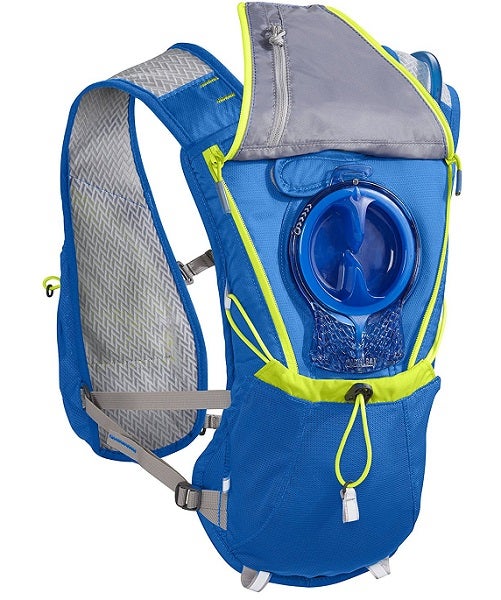
I hope this guide was helpful for finding the best hydration pack to fit your needs. If you want to comment or recommend a pack I didn’t include, please use my contact form to get in touch.
Have fun and be safe out there!

